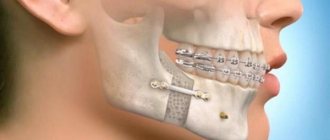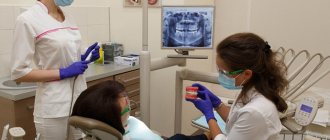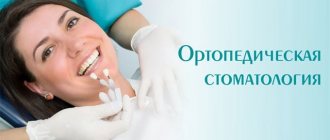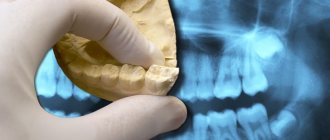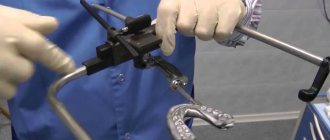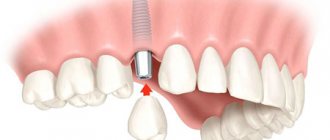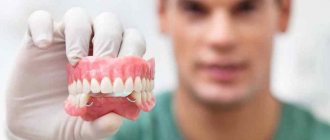Correcting the bite of an adult is a long and complex process, because you need to not only change the position of the teeth, but also correct disturbances in the usual functioning of the muscles, ligaments, spine and even the respiratory system. Therefore, the best results are achieved by an integrated approach, in which different specialists are involved in the treatment.
Correcting a bite is a complex treatment that requires a whole team of doctors
Why do they put braces?
Bracket is a bracket translated from English. Indeed, the main structural unit of modern brace systems is an arch (bracket) made of steel or various alloys. In general, it is a non-removable structure consisting of clasps glued to the teeth with special glue, through which the orthodontic arch passes. The arch is firmly fixed and is the main force that gradually aligns the dentition. It is tied to the dentition with threads or rubber rings - ligatures and secured to the molars with special metal rings. Depending on the degree of dentition disturbance, the arch is given a certain degree of tension.
To correctly place braces, the orthodontist can increase or decrease the degree of tension by changing the arch: the thicker it is, the stronger the tension.
Braces were invented at the beginning of the last century. Their design was constantly improved, new types were created, but the principle of their operation remained the same. The popularity of the method is steadily growing, especially in the modern world, where a smile plays such a big role in the life of every person. Restoring the dentition and bite reduces the risk of developing inflammatory and degenerative-dystrophic diseases of the periodontal tissues (periodontitis, periodontal disease) and premature tooth destruction.
Signs of correct bite
To begin with, we will show what a normal bite looks like and list the signs by which you can understand that it is normal.
- The main distinguishing feature of a correct bite is the tight contact of the upper and lower jaws when they close. The upper front teeth cover the crowns of the lower ones by a third, that is, the lower incisors come into contact with the palatine tubercles of the upper ones. There is no distance between the upper and lower chewing teeth, and during chewing they are in constant contact.
- Correct bite affects the harmony of facial proportions: the lower and upper jaws are symmetrical.
- There are no speech defects.
- Food is comfortable to bite and chew.
- There is no discomfort or clicking in the jaw joint.
Who should get braces?
Installation of a brace system is recommended in the following cases:
- For malocclusion - the correct closure of the teeth of the upper and lower jaws in children, adolescents and adults. Such violations occur very often, but in most cases they are invisible to the person himself and others. Severe malocclusions not only prevent a person from chewing food, but also cause speech disorders and an unattractive appearance.
- In case of an anomaly in the position of individual teeth: deviation of them outward or inward from the dentition, high or low position, gaps between the central incisors, rotation of the teeth around an axis, crowding in the dentition. All these anomalies are easily eliminated with braces.
- In the presence of unerupted (impacted) teeth. Most often these are the upper canines, lower wisdom teeth and small molars. Retention is associated with a lack of space in the dentition due to premature removal of baby teeth or improper development of the jaw. Installing a braces system allows you to expand the interdental spaces and allow impacted teeth to take their place in the dentition.
- If necessary, corpus movement of the teeth - simultaneous displacement of the crown and root to one side.
- If it is necessary to improve the appearance of the face, profile correction.
- In the process of preparing for prosthetics or dental implantation to expand the interdental space (in case of bone tissue atrophy due to long-term absence of a tooth).
Which doctor puts braces?
The installation of the braces system is carried out by an orthodontist. The tasks of this specialist include identifying and eliminating anomalies of the dental system and preventing complications associated with them. Such complications include disorders of chewing, speech, changes in facial configuration and other cosmetic defects. Malocclusion and other dental anomalies make oral hygiene difficult: due to the inability to remove plaque in hard-to-reach places, the risk of developing caries and periodontal disease increases. The work of the chewing and facial muscles of the maxillofacial area, the temporomandibular joints is disrupted, and the teeth become mobile.
Dental anomalies are mainly a congenital pathology, so the orthodontist more often has to deal with children and adolescents. But in recent years, the percentage of adult patients turning to an orthodontist has increased significantly.
An orthodontist corrects dental anomalies using removable and non-removable devices. The most famous and widely used fixed device in orthodontics is braces.
When is the best time to get braces for children?
If parents see that the child has a clearly broken bite or has some other dental anomalies, then the first visit to the orthodontist should be at the age of 3-4 years, when the baby teeth have completely erupted. But it is too early to put on braces at this age: they are heavy for baby teeth, so they will interfere with blood circulation in the dentofacial area and slow down the eruption of permanent teeth. The risk of enamel changes due to its insufficient mineralization in young children also increases. For such children, the doctor prescribes wearing special plates.
The optimal age for installing braces on teeth is 12 – 14 years. Usually by this age all permanent teeth, including molars, have erupted. At the same time, the dental system continues to develop and is easily corrected.
It is best to get braces for children between the ages of 12 and 14.
Is it possible to get braces if you have fillings or crowns?
Such problems usually occur in adult patients, since teeth decay in children and adolescents much less frequently. If you have a properly treated and filled tooth, installing a brace system is not contraindicated.
If you have artificial crowns, the issue of installing braces will be decided individually. It all depends on the material from which the crown is made: how firmly the glued structure will adhere to it.
Is it possible to get braces after dental implantation? They don't usually do that. If any correction of the dentition is required, it is carried out first and only after that is implantation possible. But sometimes the implant is a support on which a ring securing the system is installed.
When should you see a doctor?
Let's consider the cases in which you need to see an orthodontist:
- If there are defects that spoil the aesthetic condition of the smile, the patient can voluntarily consult a doctor.
- In case of disorders of the dentofacial apparatus (for example, complications after prosthetics or tissue damage), a visit to the orthodontist is simply necessary.
- Formation of a deep bite.
- The lower jaw is positioned incorrectly.
- The presence of negative habits (speech deviations, the patient often sucks his finger, etc.).
- Curled teeth.
- Secondary malocclusion.
The services of an orthodontist can eliminate problems that interfere with prosthetics, or make it possible to avoid them.
An orthodontist also treats caries, periodontitis, periodontal disease and gingivitis.
Who should not get braces?
Installation of braces has contraindications:
- Absolute – it is not possible to eliminate them: complete absence of teeth (edentia) or the absence of a large number of them;
- changes in the bone tissue of the jaw, leading to its fragility - osteoporosis and osteochondropathy;
- severe diseases of the blood, cardiovascular, endocrine (diabetes mellitus) systems;
- oncological diseases;
- tuberculosis, AIDS;
- mental illness.
- infectious-inflammatory and degenerative-dystrophic diseases of periodontal tissues (periodontitis, periodontal disease);
After treatment of these diseases, braces can be installed.
Diagnosis of orthodontic diseases
It is important for a pediatric orthodontist to see a comprehensive picture - not only the current state of the oral cavity, but also the rudiments of future teeth and the structure of bone tissue. To do this, the dentist chooses several diagnostic methods:
- Orthopantomography (OPTG) is an x-ray of the bones of the facial skeleton when all the teeth are aligned in one line.
- Teleroentgenogram (TRG) is an x-ray of the jaw in the frontal and lateral projections of the skull.
- Casts are real-size simulations of the jaw to evaluate the position, shape and size of individual teeth.
- Photographing of the face and oral cavity to assess asymmetry, external deformations, and carry out calculations.
- Computed tomography (CT) is a three-dimensional image of the jaw in digital format.
- Video recording - recording abnormal manifestations of jaw function in dynamics.
Also, a pediatric orthodontist may refer the patient for a consultation with dentists or doctors of other specializations to obtain an additional professional opinion.
Which braces are better to choose?
Currently, several types of systems are produced. You can choose the most suitable model for adults, teenagers and even children. The orthodontist and the patient decide which braces to install. Prices for individual types also vary: from inexpensive to VIP models. All models are divided according to the type of design, method of attachment to the teeth and material of manufacture.
By type of design
Based on this feature, there are two types of models:
- Ligature (classical) braces. In these models, the locks do not have caps, and the arch is fixed using special fasteners - ligatures. The advantage of these models is their ease of manufacture and inexpensive price. Disadvantages - difficulties during installation: the doctor must clearly calculate the force of the arch on the dentition and, at certain intervals, increase or decrease it, depending on how the treatment process is going. To achieve this, the patient must visit the orthodontist frequently. The treatment period may increase due to difficulties in calculating the force of impact on the dentition. Design features also make it difficult to maintain oral hygiene. The price, depending on the material of manufacture, is 30 - 45 thousand rubles.
- Non-ligating (self-ligating) braces. These designs have caps on the locks that secure the arc. The system has a gentler effect on the dentition and does not require constant correction by the orthodontist. Price from 25 – 30 thousand rubles. There are two types of non-ligature braces: active – the caps covering the locks have an active effect on the arch, increasing its strength in the desired direction;
- passive - lock covers do not affect the arc; this is a more modern type of braces; They are easy to install and there is no need to calculate the force on the arc.
Ligature and non-ligature braces
One of the most effective non-ligature passive models is the unique Damon System brace system, introduced into practice in 2000. This is a completely self-regulating, reliable system that acts gently and effectively, and does not require frequent monitoring by the orthodontist. Metal models are available (Damon Q - 80,000 rubles) and aesthetic, more expensive ones, made of transparent polycrystalline aluminum (Damon Clear - 90,000 rubles). Oral hygiene is easier with the Damon system than with other systems.
According to the method of attachment to teeth
The bracket system can be attached to the teeth in the following ways:
- The vestibular method is the most common; the clasps are attached to the front surface of the dental crowns. The system is reliable, time-tested, but its disadvantage is that it is not always aesthetically pleasing. This type of fastening is used mainly in the treatment of adolescents. The price of braces is from 10,000 to 60,000 rubles. depending on the material used.
- Lingual method - clasps are installed on the inner surface of the crowns facing the oral cavity. In such cases, braces are outwardly invisible, which is why they are preferred by adults. Disadvantages: These are more expensive models and after installation, speech problems may occur for some time. The price of lingual braces is from 100,000 rubles.
Vestibular and lingual braces
According to the material of manufacture
Bracket systems can be made from different materials:
- metal - the most common; made of titanium and some alloys with hypoallergenic properties; advantages: reliability of fastening, ensuring minimal duration of treatment and relatively low cost; cons – not very aesthetically pleasing, used mainly as braces for children and teenagers; price from 25,000 rubles;
- ceramic – locks are made of white hypoallergenic ceramics; the shade can be matched to the color of the patient’s teeth; advantages - almost invisible in the mouth; cons - less reliable and more expensive than metal ones; these braces are preferred by adults; price from 50,000 rubles;
- plastic – the locks are made of hypoallergenic plastic; advantages - lightweight, inexpensive designs; disadvantages - they break easily, are stained with food coloring and fail; most often used in pediatric orthodontics; price from 10,000 rubles;
- sapphire – made from transparent artificial sapphires; advantages - no less reliable than metal ones, have an aesthetic appearance; cons – high cost, from 60,000 rubles;
- combined - ceramic clasps are installed on the front teeth, metal clasps are installed on the side teeth; this reduces cost and improves reliability.
Types of braces by material
What do braces fix?
Braces are used to correct bites and eliminate various pathologies. Among the indications:
- malocclusion – problems with the closure of the dentition;
- disproportionate development of the jaws;
- displacement of individual teeth beyond the jaw row;
- jaw deformation during formation;
- large gaps between teeth.
Many bite problems are visible even to non-professionals, but some anomalies will only be noticed by a specialist. Dentists strongly recommend that you periodically show your child to an orthodontist to monitor the change of teeth, evaluate the growth of the jaw bones, and monitor the work of the facial muscles.
The process of installing braces for adults
The installation of braces takes place in several stages: preparation – installation – activation. The orthodontist tells the patient in detail how braces are placed before the procedure.
Preparation
Preparation for the procedure begins with a consultation with an orthodontist. Before installing braces, the doctor always carefully examines the patient and sends him for x-rays of the upper and lower jaws. After establishing the final diagnosis, he draws up a treatment plan. First of all, the sanitation of the oral cavity is carried out: all teeth subject to treatment are treated, those not subject to treatment are removed.
After this, an impression is taken of both jaws to make a plaster model of the jaw in a dental laboratory. The doctor, together with the patient, selects the most suitable bracket system in terms of design and price.
Stages of installing braces
The installation of braces on teeth is carried out strictly in accordance with the developed protocol. She may be:
- direct - the clasps are glued directly during installation to each crown;
- indirect - first a plaster model is made, the finished structure is assembled on its basis and immediately installed in the oral cavity; This method is faster and more efficient.
Installation steps:
- Installation of a labial and jaw retractor. These mouth expanders allow access to the dentition of the upper and lower jaw. The patient can completely relax.
- Cleaning and protecting teeth. The surface of the tooth crowns is thoroughly cleaned, polished and dried.
- Installation of locks. Using special cement, a clasp is glued to the surface of each tooth. The cement is dried with a lamp with ultraviolet radiation, and its remains are removed. Braces are installed first on the upper jaw, then on the lower jaw. Indirect installation allows installations to be carried out much faster.
- Installation of the arc. After the cement has hardened, an arch is pulled through each lock and secured using a ligature (using rubber bands) or non-ligature (snaps into the grooves of the locks) method. On the lateral abutment teeth (6 or 7), the system is secured using locking rings.
The entire process of installing braces is painless and takes no more than an hour.
Activation
After installing braces, under the action of the tension force created by the arch, the teeth gradually move in a given direction and change their position. As their position in the dentition changes, the tension force of the arch decreases. This condition requires correction, called braces activation. When installing classic ligature braces, the doctor adjusts the tension force once a month. With non-ligature braces, control is required much less frequently; the orthodontist individually decides how often control should be carried out.
How to tell if braces are installed correctly
This can only be determined by a qualified specialist who has experience installing various types of braces. Experienced specialists work in the St. Petersburg dental clinic “Yulistom”, this allows for high-quality installation of braces with complete elimination of the possibility of error.
Stages of consultation and treatment
You need to understand that orthodontic treatment is a long-term process that requires several appointments, or even years of treatment. One visit won't solve anything. The doctor acts as follows:
- First comes the diagnosis, which usually includes not only a visual examination, but also a variety of research methods, for example, orthopantomogram, x-ray, teleradiography. All directions are issued at the first visit.
- Afterwards, the doctor chooses a treatment and prepares the patient for it. The specialist does a lot of work without the client’s participation, for example, everything that an orthodontist does when preparing braces, crowns, etc. The doctor works using photographs, impressions and other tools, analyzing the data obtained during diagnosis.
- The third stage is the installation of hardware in the patient’s oral cavity. This usually doesn't take much time.
- Next comes monitoring how the treatment progresses. If problems are observed, the specialist will correct them in a timely manner.
- The last stage is the removal of devices to correct the dentition.
It is noteworthy that if parents know who an orthodontist is through personal experience, then the child will also most likely get to know this specialist. Many problems, unfortunately, are hereditary.
Installation of braces for children and adolescents
It is better to get braces at the age of 12-13 years, when all the permanent teeth have erupted. But in some cases, braces are placed at the age of 7-9 years, when the first permanent teeth erupt. To correct dental problems in children, the same types of braces and installation protocols are used as in adults.
In childhood and adolescence, correction occurs faster: if an adult needs several years to completely restore the normal state of the dentition, then in children this period is much shorter.
Which doctor puts
As you know, everything related to the bite is the sphere of activity of the orthodontist, whose vocation is largely aimed at correcting this defect. But sometimes it’s not easy to be sure of the professionalism of the doctor you’ve found. For this purpose, the website TopDent.ru was created in 2008.
First of all, it should be understood that in orthodontics, as in other fields of practice, experience plays a vital role. Having found out how long the doctor who puts braces has been doing this work and how many patients he is currently treating, you can roughly judge the scale of his activities. Additionally, the presence of training certificates, as well as completion of advanced training courses in installation, will help bolster confidence in the specialist.
Caring for braces after installation
After installing braces, the patient's body must get used to them. At first, they can rub the inner surface of the lips or tongue, causing pain, problems with taste and diction. But if you follow all the doctor’s recommendations, within 1 – 2 weeks after installing braces, your teeth will not hurt, all discomfort and speech disorders will disappear. The patient will simply stop perceiving braces as something foreign. If braces irritate the inner surface of the cheeks or lips, erosions and ulcers form on the mucous membrane, then, as prescribed by the doctor, the clasps are covered with special wax or silicone. A piece of wax is lightly kneaded in your hands and pressed into the lock, after cleaning and drying your teeth and braces.
Diet restrictions
For the first few weeks after installation of braces, it is recommended to eat only liquid and mushy foods. Gradually, dishes can be diversified. But it is better to grind solid foods first in a blender. It is also better not to consume very cold or very hot food and drinks. The following products will need to be completely eliminated while wearing braces:
- anything that sticks to the teeth - chewing candies (taffy, soft caramel), Turkish delight, nougat, chewing gum;
- everything that stains teeth - beets, red wine, strong black tea, coffee, Coca-Cola.
Limit: sweets and baked goods, as they are an excellent breeding ground for microorganisms present in the mouth.
How to brush teeth with braces
When starting to brush teeth with braces with a regular brush, the patient notices that it is impossible to do this efficiently. Therefore the following are produced:
- special toothbrushes with V-shaped bristles:
- cone-shaped (mono-beam) toothbrushes:
- interdental brushes:
- dental floss (floss); They come in different types depending on how closely the teeth are arranged in the dentition.
Such devices perfectly clean both teeth and braces. You should consult your dentist about which toothpaste is best to use. He will recommend the most suitable toothpaste for the patient.
You can also use irrigators to clean hard-to-reach places with a water jet. These devices do not injure the gums at all:
But even this will not be enough. If you have had braces installed, you should visit a dental hygienist at least twice a year for professional teeth cleaning.
Orthodontist visit schedule
The frequency of consultations depends on the type of braces installed. Classic ligature braces require a visit to the orthodontist to correct the tension of the arch once every 1.5 - 2 months. If ligature-free active braces are installed, the doctor may schedule less frequent visits. The easiest way to treat is with passive non-ligated Damon System braces. These are self-regulating systems, so recovery of disorders occurs faster and does not require frequent visits to the orthodontist.
If braces cause severe, increasing discomfort, you should immediately contact an orthodontist.
Why do you need to correct your bite?
- Increased abrasion, caries and tooth loss.
Normally, when chewing, the load is evenly distributed across all teeth. When there is a malocclusion, the load on some teeth increases, while on others there is practically no load. On teeth that “work for two,” the enamel wears off faster, chips appear, and the teeth themselves become loose. Teeth that are “resting” are more vulnerable to caries. - Gum diseases.
With an incorrect bite, the teeth can be tilted inward or, conversely, turned toward the lips. Eating or even normal conversation can injure the inside of the cheeks and tongue. The gums also suffer: the volume of tissue gradually decreases, exposing the roots of the teeth. - Diseases of the temporomandibular joint.
Incorrect positioning of the incisors over time leads to displacement of the jaw joints relative to each other. The pathology is accompanied by muscle spasms, bruxism, crunching and clicking while eating or talking. - Diseases of the food tract.
The bite is responsible for chewing and swallowing, and defects in the bite disrupt this process. Poorly chopped products are an additional burden on the gastrointestinal tract, which provokes gastritis, enterocolitis and problems with stool. - Breathing problems and ENT diseases.
The accumulation of bacteria in the mouth during an open bite can cause sinusitis, sinusitis, otitis media, and sore throat. - Communication problems and complexes.
For 60% of patients, braces are aesthetics; for the remaining 40%, it is either the functionality of the masticatory apparatus, or a solution to a problem with the temporomandibular joint, or a preparatory stage before prosthetics.
When and how are braces removed?
The doctor decides when to remove braces. It depends on the:
- state of the dentition - a small degree of defect (one or two crooked teeth) is restored faster than complex malocclusions;
- the age of the patient - correction is most quickly carried out in adolescence; in adults this is a longer process;
- type of braces - the fastest correction process occurs when using Damon System braces.
On average, for a complete correction of the dentition, an adult will need to wear braces for 2 to 3 years. In adolescence, this period can be reduced to a year or even several months. Only an orthodontist removes braces; removing the system yourself is prohibited.
The procedure for removing braces is painless. Stages:
- application of a special retractor-mouth dilator;
- removal of ligatures and arches with tweezers;
- removing locks from each tooth one by one;
- cleaning crowns from dental glue-cement using a special attachment for a drill;
- application of paste with fluoride and calcium to the crowns of teeth to strengthen the enamel.
The doctor can remove braces from only 1 jaw, or from both at the same time.
What to do after removal
After the braces are removed, the teeth may partially return to their original position after some time. This is especially common in adults. To prevent this from happening, special devices are prescribed to hold the teeth in the correct position:
- non-removable devices – retainers; are metal arches fixed to the inner surface of the teeth; they are invisible to others, do not cause discomfort and the patient quickly gets used to them;
- removable devices - mouthguards; These are transparent plastic caps that can be removed and put on independently; You need to wear it at least 18 hours a day.
The doctor decides how long you need to wear retainers or mouth guards. Sometimes it takes twice as long as wearing braces.
Very often, patients are interested in questions about whether it is possible to whiten their teeth immediately after removing braces. Most dentists believe that it is better to carry out such a procedure no earlier than after 4 months, since the enamel must strengthen after prolonged injury. But everything is individual, and if the defects were small, the time of wearing braces was several months, the orthodontist may allow whitening to be carried out even after a month.
When a patient has been missing one or more teeth for a long time, this leads to bone tissue atrophy and a decrease in the bone cell of the tooth. If the patient wants to have a dental implant, he will first need to expand the bone cell using braces. After removing the braces, implants can be installed immediately, since the implanted titanium root will hold the teeth in the correct position.
Find out more about modern dental implant methods in our blog.
Orthodontist appointment
A visit to the doctor to install braces includes the following steps:
- external examination of the patient’s oral cavity, identifying orthodontic problems;
- determination of a suitable structure for correction, its material and size;
- installation of a bracket system;
- periodic visits to a doctor called an orthodontist to tighten the main arch.
The specialist must determine the cause of the curvature of the dentition. The most common reasons are:
- bad heredity. Curvature of teeth can be transmitted from parents to children, and this pathology is accompanied by other dental abnormalities (diastema, trema, etc.). In such situations, braces are installed and the identified diseases are treated;
- disorders of intrauterine development. In this case, the child will experience defects as soon as the baby teeth erupt. This category of patients needs the painstaking work of a special doctor called an orthodontist;
- anomalies that develop after the replacement of milk teeth with permanent ones. It is better to consult a doctor in the early stages of deformation processes, this increases the effectiveness of bracket correction.
On average, a doctor installs braces on 15 patients per day. One appointment takes no more than 30-40 minutes and there is no need for additional treatment.
Correcting a bite with braces takes place in 2 stages:
At the first stage, the doctor selects the correct design and carefully installs it for the patient.
At the next stage, retainers or mouth guards are installed, which help consolidate the result. How long to wear them is determined by a doctor called an orthodontist. Such structures have to be used throughout life; this helps to maintain the effect obtained from treatment with braces.
Thus, the treatment of problems with malocclusion is not carried out by a regular dentist, but by a doctor called an orthodontist. His qualifications directly determine how attractive a person’s smile will become.
Is there an alternative to braces?
According to most experts, braces are the most effective device for eliminating dental anomalies. But minor violations can be corrected using other devices:
- plates - can be either removable or non-removable; are an alternative to braces for children; used mainly for bite correction; They are rarely installed in adults and only for minor pathologies;
- mouth guards for teeth straightening (aligners) – can be used not only after braces, but also independently; this is a good alternative to braces, but only for minor dentition problems; They are installed mainly in adults due to the high price.
Retainers cannot be an alternative to braces, as they fix teeth in one position, preventing them from moving. The most reliable and effective device for correcting dental anomalies is a brace system installed by an experienced orthodontist.
How long does it take to correct a bite?
Each case is individual, so without visiting a doctor it is impossible to say how long treatment will take.
The minimum treatment takes a year for the bone to grow and the teeth not to come back. The result needs to be stabilized. Patients often tell me after two months of wearing braces: “I want to take them off, everything is already straight for me!” But this is appearance. The jaw bones must anchor the teeth into their new position.
The duration of treatment also depends on the patient. The orthodontist puts a certain force into the braces, which weakens by the next visit. That is why it is important to strictly visit the doctor once a month so that you do not have to prolong the course of treatment.
My teeth began to loosen. Something is going wrong?
Loose teeth after installation should not scare you. The teeth will be in motion throughout the treatment period. Essentially, we move our teeth: somewhere the bone dissolves, somewhere it appears. Six months after treatment, the teeth will return to normal.
The purpose of braces is to change the position of hard and soft tissues adjacent to the tooth. But this is not enough to correct the bite. Teeth may move back apart some time after braces are removed if a retention device is not in place. After correction, retainers must be installed to keep the teeth stable in their new position. If this is not done, the effect of wearing braces will gradually disappear.
Uneven teeth
You visually notice that permanent teeth are growing unevenly (this can be from 5 years of age and older). Baby teeth that grow unevenly and with rotations are not an indication for orthodontic treatment and do not require correction. If, when the first permanent teeth erupt (usually the lower incisors), you see that the teeth are erupting unevenly, or are starting to erupt from the tongue, this is a reason to contact an orthodontist. Most often, the first permanent teeth erupt at the age of 5.5-6.5 years. It is important not to miss the moment: during this period, the child’s jaws are actively growing - this is the most effective time when we can help create space for the erupting teeth.
Our advantages:
Smile Studio is the first and only orthodontic center in Moscow that specializes exclusively in bite correction. We do not provide other dental services!
| Extensive clinical experience During his practice, several hundred patients were treated. We treat pathologies of any complexity. We work on all types of bracket systems. | Affordable prices Low cost and installment program make our offer one of the best orthodontic services on the market! | High quality equipment We are the exclusive partner of the leader in the production of high-quality orthodontic products. | Convenient location We are located in the historical center of Moscow, 500 meters from the Baumanskaya metro station and the Third Transport Ring. |
What can and should the patient do?
- If you are moving to another city or country, tell your doctor. Ask him to describe the treatment program in detail, take pictures (panoramic, teleroentgenogram, portrait and intraoral photos, CT, etc.), make a copy of the card or order an extract from it.
- The statement should contain information about all procedures performed, starting with the type of braces installed. All these records will help the new dentist quickly get involved in the process.
- Orthodontists once studied at the same universities, and today they often communicate at conferences and specialized forums. Perhaps your “old” doctor will recommend you a worthy professional who can efficiently continue the work he started and bring it to the planned result.
- It is best to choose a new orthodontist before moving. The doctor will need time to review the old treatment plan. In addition, there will likely be many more nuances that will need to be agreed upon and ironed out before the correction can be continued. And the longer the break lasts, the longer the treatment period will be.
Unfortunately, changing a doctor will be accompanied by additional financial costs. And it’s not just the different tariffs for installing braces in Moscow and other countries of the world.

